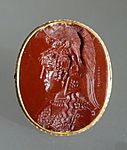Athena Parthenos
The statue of Athena Parthenos (Ancient Greek: Παρθένος Ἀθηνᾶ, lit. 'Athena the Virgin') was a monumental chryselephantine sculpture of the goddess Athena. Attributed to Phidias and dated to the mid-fifth century BCE, it was an offering from the city of Athens to Athena, its tutelary deity. The naos of the Parthenon on the acropolis of Athens was designed exclusively to accommodate it.
Many artists and craftsmen worked on the realization of the sculpture, which was probably built around a core of cypress wood, and then paneled with gold and ivory plates. At about 11.50 meters high, the statue reflected the established aesthetic canon of the severe style (clothing) while adopting the innovations of the high classical (leg position). She was helmeted and held a large round shield and spear, placed on the ground to her left, next to her sacred snake. Clothes, jewellery, accessories, and even the ...Read more
The statue of Athena Parthenos (Ancient Greek: Παρθένος Ἀθηνᾶ, lit. 'Athena the Virgin') was a monumental chryselephantine sculpture of the goddess Athena. Attributed to Phidias and dated to the mid-fifth century BCE, it was an offering from the city of Athens to Athena, its tutelary deity. The naos of the Parthenon on the acropolis of Athens was designed exclusively to accommodate it.
Many artists and craftsmen worked on the realization of the sculpture, which was probably built around a core of cypress wood, and then paneled with gold and ivory plates. At about 11.50 meters high, the statue reflected the established aesthetic canon of the severe style (clothing) while adopting the innovations of the high classical (leg position). She was helmeted and held a large round shield and spear, placed on the ground to her left, next to her sacred snake. Clothes, jewellery, accessories, and even the statue base were decorated, mainly with the snake and gorgon motif.
The statue was lost at an unknown date sometime in the first millennium. Several replicas and works were inspired by the original.
Ivory, a fragile material and subject to desiccation, was maintained with oiled water that was left available in a basin at the foot of the statue. The oil layer left a protective film preventing evaporation and giving shine to the ivory.[1]
The luxury of the statue contrasted with its interior filled, like all chryselephantine statues, with "levers, corners, nails that cross the machine from side to side, ankles, pitch, clay and other things as shocking to the eye, not to mention an infinity of flies or shrews", as Lucian describes in Dream or the Rooster, XXIV.18.[2]
According to sources in 438 BCE (from the consecration of the statue) or in 432 BCE (just before the outbreak of the Peloponnesian War), Phidias was accused of diverting part of the precious metals used to make the statue of Athena Parthenos, which was also sacrilege in itself since gold belonged to the goddess. Arrested, he would have escaped, which was interpreted as an admission of guilt. He reportedly fled to Olympia where he made the Chryselephantine statue of Zeus and where he died. For historians, an accusation against Phidias would then have been a way for Pericles' political opponents to attack the archon.[3][2] Later, between 300 and 295 BCE, the tyrant Lachares allegedly had the gold plates removed to pay his troops. However, the veracity of this gesture is difficult to establish. If Lachares had taken gold permanently, he committed sacrilege. If his gesture was a simple "borrowing" from Athena, the rule was to repay with interest, difficult if the only way to obtain funds was to strip the goddess.[4][2]
The Parthenon was ravaged by a fire at an indeterminate date in late antiquity, causing serious damage. The roof collapsed. The Doric columns of the naos were replaced by columns from the Hellenistic stoas of the Roman agora.[5] The statue was damaged but restored. It may have been transported to Constantinople with the Chryselephantine statue of Zeus of Olympia where it could still have been in the 10th century CE.[4][6] Another hypothesis is based on the presence of traces of a second base. The statue of Athena Parthenos could then have been replaced, at an indeterminate point in time.[7] Until the edict of Theodosius in 380, the Parthenon retained its pagan religious role. It then seems to have experienced a more or less long period of abandonment. Somewhere between the fifth and the seventh century, the building was transformed into a church. Sources do not mention the statue at that time; it is therefore not possible to know if it had been destroyed or transported to Constantinople.[8]







































Add new comment